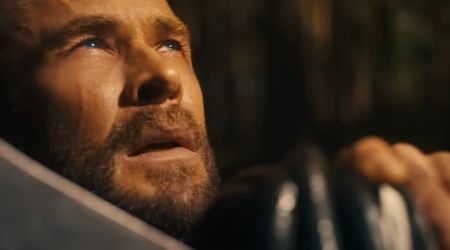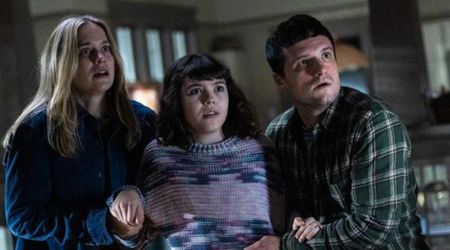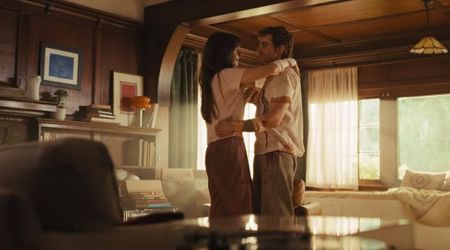'Varda by Agnes' is a farewell analysis and masterclass on Agnes Varda's work and vision, detailing the everyday people she filmed

In February 2019, at a press conference for 'Varda by Agnes' at the 69th Berlin Film Festival, Agnes Varda said the film was a way of saying goodbye as she has had enough of talking about her films. On March 29 she died of cancer at the age of 90.
Just like David Bowie's final album 'Blackstar', foreshadowing his death, in 'Varda by Agnes', Varda wants to "share" her final analysis of her body of work so that her ideas if not her body finds immortality. Despite its slow, sensual exploration of her work in films, photography and digital art, there is an urgency of needing to pass on her knowledge, her experience, her wisdom from lessons learned over a career that has spanned decades.
That this is her masterclass is evident in the way she starts the film -- her director's chair on stage facing a group of young filmmakers. Her advice-tinged analysis of her work lets us peek behind the curtains to look at her method of "cinewriting", of "choices made throughout the making of a film -- what do you film? Fluid or abrupt shots? Clear isolated images or crowded spaces?"
She talks about how "in editing and mixing, we finish the 'cinewriting'", comparing the term to stylistic choices made by an author while writing a book. In a semi-rebuke, she says, "Nothing is trite. If you film people with empathy and love... you find them extraordinary as I did."
This generosity of vision and voice is continually reflected when she talks about her process like filming. For instance, she remembers filming a woman sitting by herself in a laundromat in Los Angeles, running her fingers through her greasy hair, tangling and untangling the strands.
She describes it as an arresting image of "solitary, sensual exploration". She talks of a baker scouring his bread dough with his razor. Of representing the silent majority of people she interacted with in daily life from the hairdresser to the street artist performing where she was filming.
She also talks of engaging with the "enraged minority" like the Black Panthers or the solitary enraged woman in 'Vagabond'. Unlike typical retrospective films on an auteur's work (usually male) that is presented as the labors of a "lone wolf" genius, birthed in splendid isolation that obscures other people's labors and contributions, Agnes Varda takes a feminist, collaborative approach to this film version of her "greatest hits" (and flops).
The effect is that her images and art are always put in a relational, contextual framework of people she collaborated with, and/or the associations she had with the places or the subjects she filmed. This is especially true when she speaks about the film she made about her dying husband, based partly on the notes he made about his childhood growing up in a garage.
She talks of using tight close-ups on him because she wanted to be as close to him as possible. She illuminates herself and her ideas by reflecting them off the people she has encountered and filmed, often taking scenes from her previous work and interviews she did when she was younger, spliced with her words in the present while filming.
By doing this, she becomes an unobtrusive but very real presence that audiences can engage with more intimately, like a co-conspirator, much like how Jane Birkin interacted with Varda in the film 'Jane B.' that Varda made about Birkin turning 40.
In the film, Varda draws people in, either by interviewing them or having them interview her -- a back and forth that registers as a conversation rather than a monologue. She also is obsessed with presenting her ideas as triptychs.
The film itself is divided into three parts -- discussing her film, photography and finally her digital art and installations, in turn. She starts the film by saying three words guide her work -- "Inspiration, Creation, Sharing".
Her place of inspiration and reverie -- the beach -- is also divided equally between sky, sea, and earth. The beach as an idea, landscape, and imagery is a central motif in 'Varda by Agnes' that she constantly refers, and returns to, She even disappears into a sandstorm at the beach in the film's final moments.
Another key idea she keeps repeating is about mixing reality with fiction, revealing her love for documentary films and the need to infuse her fictional work with documentary realism -- it is an aspect of her work that won her such acclaim in New Wave films like 'Cleo from 5 to 7' that show real people reacting to the fictional character of Cleo that she had created.
'Varda by Agnes' shows how to harness the best of both worlds -- how to capture reality and make it beautiful (and accessible) by infusing touches of the surreal and flourishes of the fictional to create an artistic portrait of the truth. If not for her death, we wonder what an 'Agnes by Varda' film would look like.
'Varda by Agnes' opened on December 5 at American Cinematheque's Aero Theater in Los Angeles and will be released in select theaters nationwide. A career-spanning Varda retrospective opens December 20 through January 6 at Film at Lincoln Center, New York, in partnership with Janus Films. See showtimes and get tickets here.










